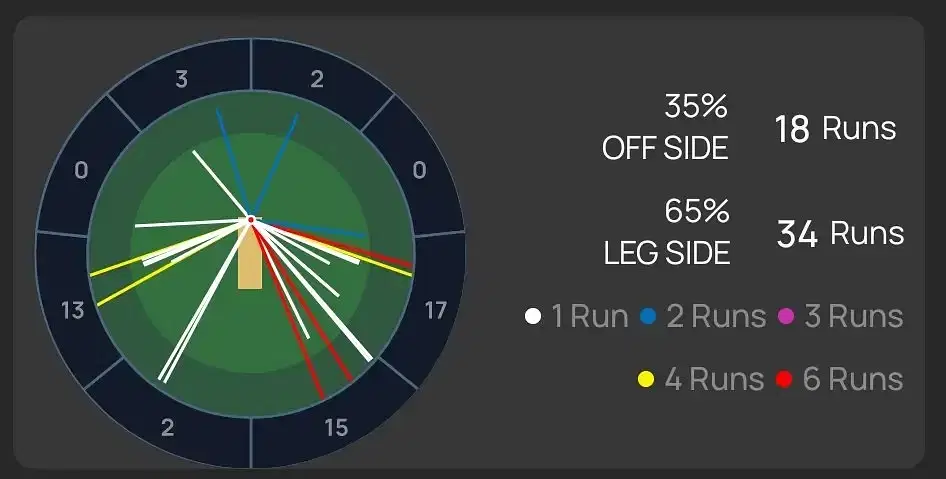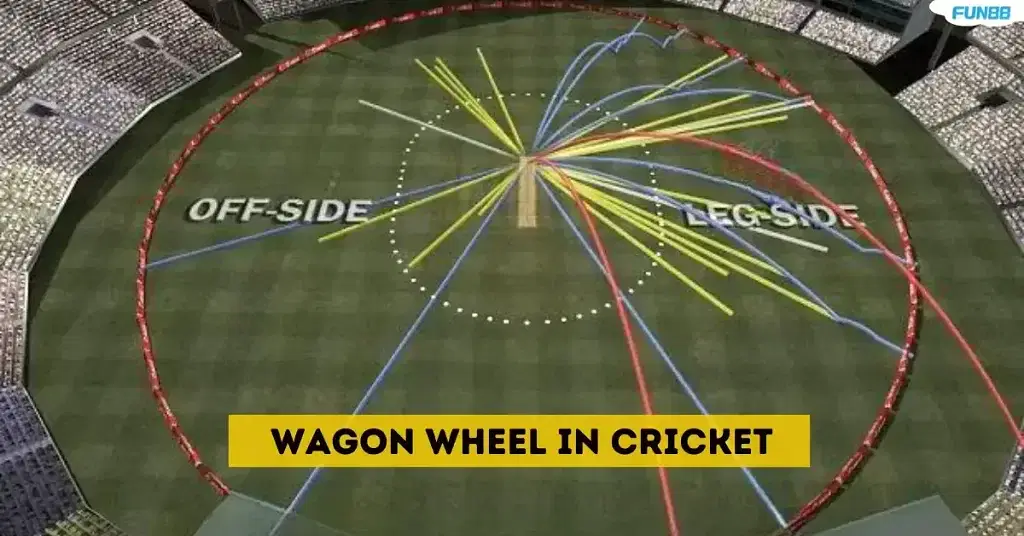Statistics play a pivotal role in understanding cricket performances. One tool that has gained recognition among players, coaches, and fans alike is the wagon wheel. But what exactly is it? How does it work? Why is it important? We’ll break down this fascinating visual representation and explore its impact on the game.
What is a Wagon Wheel?

A wagon wheel in cricket is a graphical representation that illustrates the scoring zones of a batter. It’s typically divided into sections, each corresponding to specific areas on the field where the batter has directed the ball, be it through boundaries or singles.
Picture a circular chart that looks like a wagon wheel. The centre represents the batter’s position, while the spokes—those straight lines radiating outward from the centre—represent different scoring locations on the cricket field.
How Does It Work?
The wagon wheel functions by tracking the runs a batter accumulates in various regions of the field. To create it:
- Data Collection: Each shot played by the batter during an innings is recorded, particularly where the ball lands—e.g., boundaries, singles, or doubles.
- Mapping the Zones: These locations are mapped against a standard field layout, typically divided into segments based on scoring areas.
- Visual Representation: The resulting chart displays coloured sections denoting the volume of runs struck in those areas. A larger section indicates more runs scored in that spot, while a smaller one shows lesser activity.
By analysing a wagon wheel, observers can glean insights into a batter’s scoring patterns and tendencies, thus providing a comprehensive look into their gameplay style.
The Significance of the Wagon Wheel in Cricket

Performance Analysis
One of cricket’s most important aspects of the wagon wheel is its use in performance analytics. Coaches and analysts utilise this visualisation to assess a batter’s strengths and weaknesses. By examining the chart, they can identify preferred scoring areas, thereby shaping targeted training and strategies. For instance, if a batter tends to score heavily on the leg side, the coach can develop drills to enhance runs on the off side.
Opposition Strategy
Opposing teams can use the wagon wheel to strategise field placements when preparing to face a specific batter. A batting tendency toward particular areas can allow bowlers to target those zones, increasing the chance of dismissals by limiting the batter’s scoring options. In this way, the wagon wheel becomes a tool not only for individual improvement but also for anticipating opponents’ strategies.
Game Commentary
For fans watching live matches or on television, the wagon wheel in cricket enhances the viewing experience. Commentators often refer to it to provide context around a particular innings. This visualisation allows fans to see where a batter excels, crafting a narrative regarding their performance and decisions. It makes statistics engaging and easy to understand, bridging the gap between raw data and compelling storytelling.
Related Read: What is a Free Hit in Cricket? Various Formats Rules
Components of a Wagon Wheel
Let’s break down the different components of a wagon wheel for clarity:
1. Central Point
At the centre is the position where the batter stands. It serves as a reference point for understanding the scoring areas.
2. Scoring Zones
The outer sections of the wheel represent areas of the cricket field where runs have been scored. These are usually divided into six to eight primary segments, like:
- Square Leg
- Midwicket
- Long On
- Straight Drive
- Off Side
- Cover
3. Run Totals
Each segment is often filled with a colour or pattern to indicate the number of runs scored in that area. The more runs scored, the larger and more prominent that area will be on the chart.
4. Shot Type Indicators
Although not always included, some advanced wagon wheels might highlight the type of shots played in each area. For instance, a bash through cover might be marked differently from a delicate glance to a fine leg, providing insights into the batter’s technique and approach.
Historical Context: The Evolution of the Wagon Wheel
The concept of using visual analytics in cricket isn’t new. However, the full-fledged integration of the wagon wheel in cricket has been popularised in recent years, aligning with advancements in technology and data collection. Traditionally, cricket relied heavily on numerical statistics in scorebooks, which often lacked context. As broadcasts began embracing analytics, tools like the wagon wheel emerged.
Cricketing analysts recognised the potential of blending statistics and visuals, leading to the creation and diffusion of the wagon wheel. Initially, it was adopted by broadcasters and analysts but has since found its way into coaching frameworks, player assessments, and fan engagement.
Interpreting the Wagon Wheel: Reading Between the Lines
Now that we understand the mechanics of the wagon wheel, let’s focus on how to interpret this tool effectively. Here are some pointers to decipher its details:
Analysing Major Scoring Areas
Upon looking at the wagon wheel, the first thing to notice is where the batter has concentrated their efforts. Large sections in certain areas indicate stronger batting prowess. For instance, if you observe a batter scoring heavily on the leg side, you can infer they may have a strong wrist, allowing them to manipulate the ball’s direction adeptly.
Identifying Weaknesses
Conversely, smaller sections—or blank segments—can reflect a batter’s vulnerabilities. If a batter has an unusually low scoring area on the offside despite having a relatively even distribution elsewhere, it might point to a necessary area for improvement. Coaches often use this knowledge to direct focused training sessions.
Trends Over Time
Wagon wheels can be analysed over multiple innings or matches to identify trends. Seeing a batter’s growth in specific scoring areas or adaptation to bowlers’ strategies can indicate development and adjustment made over time. Accordingly, this historical perspective enriches the batting narrative.
Contextual Analysis
Always consider the match situation when interpreting the wagon wheel. For instance, a batter might prefer aggressive shots in a T20 match, creating a distinct wagon wheel compared to a Test match where restraint is necessary. The context of conditions, opposition, and match specifics must be considered for meaningful analysis.
Advanced Usage of the Wagon Wheel
Integration with Other Stats
While the wagon wheel in cricket is powerful, it becomes even more potent when combined with additional statistics. Metrics like strike rate, average runs per scoring area, and shot type can create a comprehensive profile of a batter’s scoring approach. This amalgamation fosters a deeper understanding of strategic batting.
Technology and Software
There has been a surge in the use of technology to analyse the wagon wheel and other performance metrics. Various software and applications now exist to manage data collection seamlessly, allowing for real-time analysis. These tools make it easier to adapt and respond during games, paving the way for data-informed decision-making.
Coaching Applications
In a coaching environment, the wagon wheel can direct training focus. Coaches can use the chart to tailor drills specific to a batter’s needs. By focusing on underexplored sectors, they can push players to expand their game and become more versatile.
Example: Analysing a Famous Innings
To illustrate the practical application of the wagon wheel in cricket, let’s analyse a famous innings—say, a pivotal match where a blistering century was scored. Imagine a batter who capitalises on the square leg and midwicket regions, with the wagon wheel revealing extensive growth in these areas over previous matches.
This visualisation would demonstrate the batter’s refined technique in playing the pull and hook shots. As a fan or analyst, this insight informs you of the runs scored and the skill evolution taking place in real time.
Also Read: How to Bet on Cricket? A Beginners Betting Guide
The Importance of Visualisation in Cricket
The wagon wheel in cricket offers a wealth of knowledge about batting performance. This simple yet effective visual representation allows for deep insights into a batter’s strategy, strengths, and areas for improvement. As cricket continues to evolve, the importance of data-driven analysis and visualisation will only grow, highlighting the wagon wheel’s significance in understanding the intricate dance between batter and ball.
By embracing this tool, players, coaches, and fans alike can enrich their grasp of the game, ensuring that cricket remains both a competitive sport and a beloved form of entertainment. Understanding the art of batting through the wagon wheel allows enthusiasts to appreciate the game’s nuances engagingly.
So next time you see a wagon wheel during a broadcast, remember—it’s not just a chart. It represents battles fought on the field, skills honed over countless hours, and the relentless pursuit of excellence embodied by the game of cricket.
Frequently Asked Questions (FAQs)
The wagon wheel in cricket originated when analysts and commentators sought a more descriptive way to present batting statistics. It gained traction as technology evolved, allowing for better data visualisation. This representation filled the gap left by traditional statistics, providing a more engaging way to analyse a batter’s performance.
While the wagon wheel primarily focuses on batting performance, similar visualisations can be adapted for bowling analysis. Bowlers may have wheels that depict where most deliveries land, allowing teams to strategise field placements and help them identify patterns in their bowling.
Regularly reviewing the wagon wheel in cricket can significantly enhance a batter’s game. Analysing their performance after every few matches can provide insights into their scoring patterns. This allows players to make necessary adjustments and focus training on weaker scoring zones.
The wagon wheel can significantly aid team strategy. By examining a batter’s favoured scoring zones, teams can strategically place fielders, minimising run-scoring opportunities. Understanding team dynamics and individual preferences fosters a more competitive edge.
While the wagon wheel in cricket is powerful, it can have limitations. For instance, it does not convey the context of a match or the conditions during which runs were scored. Supplementing the wagon wheel with other statistics, such as match situations and shot types, is essential to gain a comprehensive understanding.
Certainly! The data represented in the wagon wheel can be valuable during player recruitment. Analysts looking for new talent can assess a player’s scoring areas and preferences, aiding decisions on whether a player’s profile aligns with the team’s strategic objectives.
A batter can use the wagon wheel in cricket to identify underutilized scoring areas. By recognising which segments of the field they tend to avoid, they can work with coaches to learn new shots or techniques aimed at exploiting those zones, making them more well-rounded in their batting approach.
Yes, the wagon wheel in cricket can vary across formats such as T20, ODI, and Test matches. Aggressive formats might display a more extensive range of areas scored, while longer formats may indicate more caution. Analysing these differences can shed light on players’ adaptability and game strategy.
Advancements in technology, such as ball-tracking systems and data analytics software, improve the accuracy of collecting and analysing data for the wagon wheel. These technologies allow for precise recording of shot placements and ranges, resulting in more reliable and actionable insights for batters and coaches.
When fans see a wagon wheel in cricket during a match, they should consider the relative size of each segment, the scoring zones favoured by the batter, and how this might impact the game. Observing a batter’s strengths and strategies can deepen appreciation for the tactical elements of cricket, enhancing the overall viewing experience.
Star it if you find it helpful.

